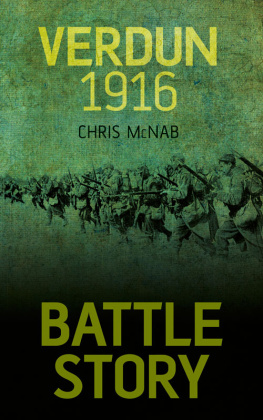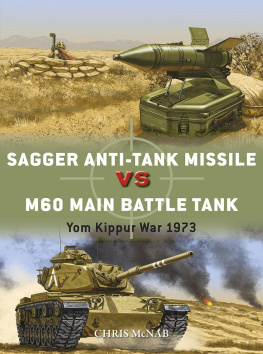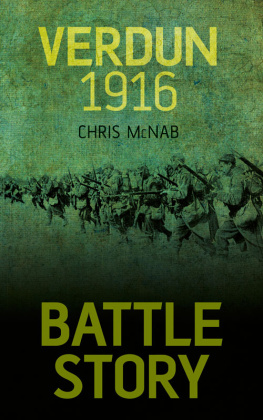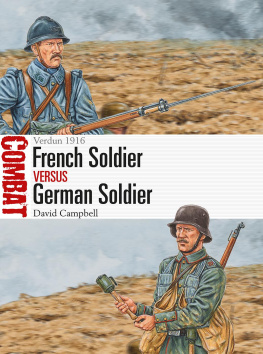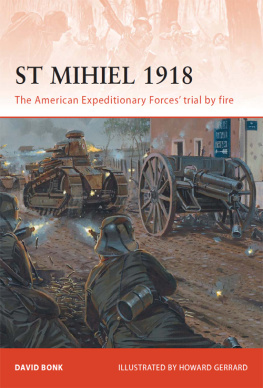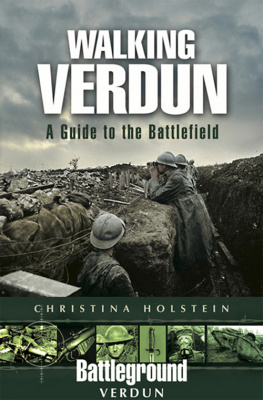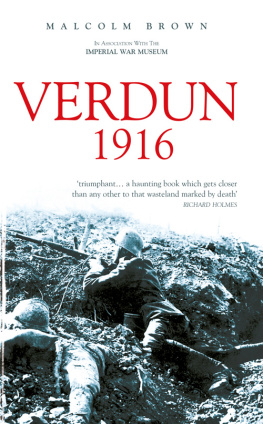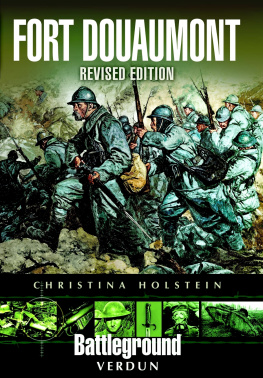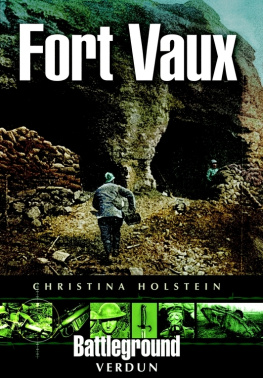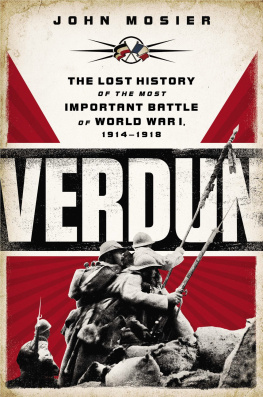
If you havent seen Verdun, you havent seen anything of war.
A French infantryman, quoted in Ousby, Verdun
CONTENTS
Taking the offence
Falkenhayns Plan
The Commanders
The Soldiers
The Kit
Tactics
German Preparations
What Actually Happened?
Driants Defence and Douaumonts Fall
Ptain and the Beginnings of the French Recovery
Expanding the Battle
The Grinding Mill
Recovery
The October Offensive
Tired Victors
Beyond Verdun
1 Situation on Western Front, January 1916.
2 Poilus returning to their billets after a spell on the frontline on the Western Front. ( The War Budget , 23 March 1916)
3 The defender of Verdun: General Ptain, with President Poincar and General Joffre. ( The Illustrated War News , 15 March 1916)
4 Phillippe Ptain. (Wikimedia Commons)
5 Erich von Falkenhayn. (Wikimedia Commons)
6 French cavalry, part of the forces in reserve behind Verdun, conduct an attack exercise in 1916. ( The Illustrated War News , 29 March 1916)
7 Moroccan Tirailleurs returned from the frontline trenches to rest. ( The Illustrated War News , 15 March 1916)
8 French soldier, 1916. ( The Illustrated War News , 19 April 1916)
9 German soldier, 1916. (Authors collection)
10 On a rocking frame mount: A single-barrelled revolver-cannon employed by the French at Verdun. ( The Illustrated War News , 5 April 1916)
11 A French soldier prepares to throw a grenade, while his comrade prepares the fuse of another. ( The Illustrated War News , 5 April 1916)
12 Tracking a 6in shell in flight: A French gunner following with his eye a long-range shot. ( The Illustrated War News , 22 March 1916)
13 The Poilus cup of tea langlaise at the front. ( The Illustrated War News , 5 April 1916)
14 French bayonet charge, 1916. (Authors collection)
15 Battle of Verdun, 21 February 191616 December 1916.
16 Fort Douaumont, 1916. (Wikimedia Commons)
17 An angle of the fort against which thousands of German guns hammered in vain. ( The War Budget , 20 April 1916)
18 French defence work representative of many miles of the French front. ( The Illustrated War News , 15 March 1916)
19 After a heavy bombardment, the German soldiers attacked Verdun over devastated ground such as this. ( The War Budget , 30 March 1916)
20 Refugees from bombarded Verdun. ( The Illustrated War News , 15 March 1916)
21 Verdun and environs: To the right, the cathedral towers mark the city; to the left, a shell is seen bursting. ( The Illustrated War News , 29 March 1916)
22 The destruction of a French church by German shells: The bombardment of Vaux-Devant-Damloup, near Verdun. ( The Illustrated War News , 3 May 1916)
23 Wrecked buildings in the village of Douaumont. ( The Illustrated War News , 15 March 1916)
24 The French forces at Verdun were continually engaged in preparing, emplacing or repairing barbed-wire defences in the landscape. ( The Illustrated War News , 22 March 1916)
25 Mealtime in a French trench dug-out. ( The Illustrated War News , 19 April 1916)
26 At Verdun: One of the reasons for General Ptains confidence batteries being held back in reserve. ( The Illustrated War News , 22 March 1916)
27 Feeding the French artillery at Verdun: Supplies of ammunition conveyed to the batteries by motor lorry. ( The Illustrated War News , 5 April 1916)
28 French efficiency in motor transport: A convoy of motor wagons on their way to the front with munitions. ( The Illustrated War News , 22 March 1916)
29 To pave the way for the guns: French motor vehicles transport logs for constructing roads for artillery, near Verdun. ( The Illustrated War News , 22 March 1916)
30 At Verdun: An unexploded German shell enclosed in wire netting to prevent accidental discharge by French soldiers. ( The Illustrated War News , 22 March 1916)
31 A French field searchlight on its travelling carriage, waiting to be moved to the firing line. ( The Illustrated War News , 19 April 1916)
32 Air torpedoes at Verdun: A French soldier preparing to fire one under the direction of an officer. ( The Illustrated War News , 19 April 1916)
33 Effects of French heavy guns near Verdun: Remains of a captured German trench wrecked by bombardment. ( The Illustrated War News , 22 March 1916)
34 Paris motor buses about to head out to the frontline to deliver provisions. ( The Illustrated War News , 15 March 1916)
35 French soldiers repairing wire entanglements. ( The Illustrated War News , 24 May 1916)
36 Drinking water for the frontline trenches. ( The Illustrated War News , 24 May 1916)
37 Light railways were used by the French for transporting the wounded to a field ambulance. Here we see a stretcher case on a truck. ( The Illustrated War News , 5 April 1916)
38 Hecatombs Sacrificed to the moloch of Prussian militarism: Massed infantry attacking at Verdun mown down by the French guns. ( The Illustrated War News , 29 March 1916. Drawn by Frederic de Haenen)
39 A French bivouac in a church in the environs of Verdun. ( The Illustrated War News , 19 April 1916)
40 Relief column on its way to the frontlines at Verdun. ( The War Budget , 16 March 1916)
41 French artillery depot behind the Verdun battle zone. ( The Illustrated War News , 15 March 1916)
42 One of Frances famous motor guns in action dropping shells into the German lines 5km (3 miles) away. (The War Budget , 16 March 1916)
43 German prisoners at Verdun: One of the batches lined up in a village for General Joffres inspection. ( The Illustrated War News , 22 March 1916)
44 German prisoners working under a French guard. ( The Illustrated War News , 7 June 1916)
45 The Road-bed cartoon depicting the slaughter at Verdun. ( The War Budget , 30 March 1916. New York Evening Telegram )
46 Heavy artillery, such as these siege guns held in reserve, were critical to the French victory at Verdun. ( The Illustrated War News , 19 April 1916)
47 Supplies of French heavy shells on their way to the firing line: Motor ammunition wagons on the road. ( The Illustrated War News , 22 March 1916)
48 The growing pile cartoon depicting the effect of defeat at Verdun on Germanys hopes. ( The War Budget , 16 March 1916. Montreal Star )
49 The burning debris of a German aeroplane destroyed by the French in the region of Verdun. ( The Illustrated War News , 24 May 1916)
50 Section of the Maginot Line, 1944. (Authors collection)
It is the fate of some towns, cities, regions and even entire nations to have histories written in blood and war. Usually this situation is a by-product of location, the place sitting on some political or social fault line that periodically gives way to violence and upheaval. The area in and around Verdun in northern France is one such place.
The town of Verdun sits some 225km (140 miles) due east of the French capital, Paris, roughly 40km (25 miles) from the German border. Its origins stretch back to the fourth century BC , when Celtic tribesmen founded the settlement named Virodunum, on the banks of the River Meuse. The settlement grew steadily over the next 500 years, the Celts then the Romans appreciating its strategic position for controlling one of the Meuses key crossings, and its convenient location between the towns of Reims and Metz. The Huns also recognised Verduns inherent advantages, sacking the town comprehensively in AD 450.
If we were to look for the earliest roots of the 1916 battle that is the subject of this book, then the Treaty of Verdun in AD 843 would be a reasonable place to start. The treaty saw the complicated and contentious division of the Carolingian Empire between the three surviving sons of Louis the Pious (r. 81440). Although this political solution brought a temporary end to the immediate struggles of the Carolingian Civil War, its effect on Verdun itself was to make the town a political ping-pong ball, knocked between the French and the Germans. The town was largely under German authority until 1552, when it was diplomatically acquired for France (along with Metz and Toul) by Henry II (r. 115489), although it took more than 100 years for the Germans to acknowledge French sovereignty, as part of the Peace of Westphalia treaties (signed MayOctober 1648).
Next page
